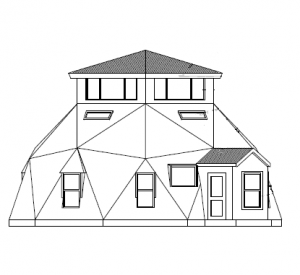 At first glance, the Haven appears to be a re-creation of the famous geodesic dome developed by R. Buckminster Fuller, popular in the 1960s and 1970s. Technically, our Haven homes are a hybrid design of a geodesic dome, a yurt and a conventional structure. Certain qualities from the Navajo Hogan structures are inherent in the design as well.
At first glance, the Haven appears to be a re-creation of the famous geodesic dome developed by R. Buckminster Fuller, popular in the 1960s and 1970s. Technically, our Haven homes are a hybrid design of a geodesic dome, a yurt and a conventional structure. Certain qualities from the Navajo Hogan structures are inherent in the design as well.
For decades, the creators of Envirohaven have been inspired by the geodesic domes and revolutionary work of Fuller. During our more than 50 combined years of construction and home building experience, our focus has been to create more for less; more comfort, efficient use of space and efficient use of energy with a structure that’s simple, affordable, and sustainable. Although we’ve been geodesic dome fans, we found that domes don’t meet all of the above criteria. The following 7 reasons illustrate why the Haven is a unique design created with the specific intention of being holistically sustainable.
Reason #1:
Only 40 triangles in 2 different sizes are needed for a Haven home that encloses 1550 sf.
Current dome kit models are based on “3V” or “4V” style domes requiring 75-105 triangles to assemble; creating 105-150 seams across the dome’s surface on the exterior and interior. Larger triangles are the most efficient use of labor and material. Finding tradesmen to provide roofing and drywall for the Haven in remote, off-grid areas will be no more difficult than for rectangular homes.
We’ve been able to create this improved design while incorporating one of the most important and sustainable features of true geodesic domes. Like geodesic structures, the Haven has ~30% less surface area than a typical 1550 sq. ft. home, resulting in ~30% less construction materials needed and less exterior wall area exposed to hot and cold outside temperatures. The reduction of exposed exterior wall area provides less surface area where warm air from the inside will be able to escape as it travels toward the cold outside; vice versa in the summertime. The aerodynamic shape of domes and Havens as well, cause air to be deflected rather than push against and then through walls. This further increases energy efficiency. Although a modified structure, Havens maintain the inherent strength traditional domes.
Reason #2:
Haven Homes are designed to generate MINIMAL waste
Off-the-shelf building materials normally come in rectangular shapes; therefore, cutting rectangles down into many small triangles creates waste and increases the cost of construction.
The Haven design allows left over pieces from our initial triangular cuts to be used to cover the smaller triangles around the upper edges of the Haven. Exterior 4’x8’ sheeting and interior drywall 4’x8’ sheets are used almost in their entirety.
Fewer interior seams reduce labor and material costs for drywall as well.
Reason #3:
Rooms in the Haven are the rectangular, private spaces we are accustom to
Triangular pieces are used along the perimeter of the Haven’s walls that are 12’ in length and almost perpendicular on the lower level. The walls in the upstairs room are completely perpendicular, and thus, standard furniture can be placed against the exterior walls without wasting interior floor space. The lower level bedroom space of 12’x12′ is entirely usable.
The hybrid design creates the same kind of quiet and private divided space we are used to in our traditional homes.
Reason #4:
The shape of the Haven home makes it easy to conform to code requirements for placement of sewer vents and chimneys.
The Haven design maximized use of space by running sewer vents, and piping through the framing area created by the second level copula and second level bathroom.
Reason #5:
Standard windows and doors can be used without structure modification
The large triangular panels of the Haven, allow the windows to be perpendicular to the floor. The need for much more expensive laminated glass, required by the Universal Building Code for windows not set perpendicular to the floor, is eliminated. We are able to provide the most sustainable and efficient dual pane windows on the market today while maintaining affordable package prices!
Reason #6:
Haven design creates a central mechanical core
To minimize use of resources and costs to buy and replace them, the Haven design was created with a central core allowing for the HVAC and hot water systems to be placed as close as possible to where it will be needed, minimizing mechanical run lengths and creating the most efficient system possible. In addition, HVAC, electrical, and plumbing materials are more accessible for maintenance than we find in most conventional homes.
Reason #7:
The structural integrity of the Haven is found in the skeleton framing which creates it’s shape in addition to the 5 interior support posts.
The Haven creates an upper level with an 8ft. + ceiling height which allows for 360 degree views. The tallest part of the Haven structure is fully utilized as living space. While conventional geodesic domes are self-supporting, traditionally they don’t utilize the full height in the center of the home.
While the Haven has borrowed the ingenious ideas developed by Buckminster Fuller, we hope we’ve made clear why the Haven has expounded on his ideas to develop something new and improved. The result of this new more efficient, more cost effective, more usable design is a holistically sustainable home. All these qualities add up to affordability for people who have, up until now, found “green” and “sustainable”, out of their economic reach.
If you have dome building/living experience or questions regarding the technicalities of these differences presented here, we look forward to hearing from you in our Comments section below.






You must be logged in to post a comment.